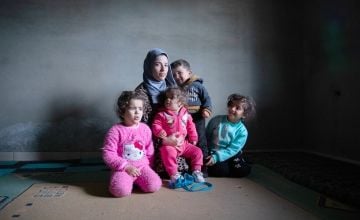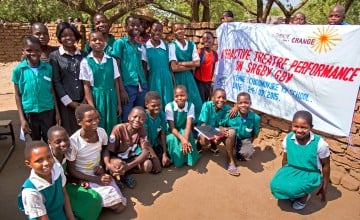
Read our 2024 annual report

Knowledge Hub
Gender-based violence (GBV) has been recognized as an international public health crisis and human rights issue. Here are five reasons why it persists.
Violence against women and girls was first recognized as a violation of human rights in 1992. Even before then, however, activists, policy-makers, and humanitarians were working tirelessly to end GBV. Statistically, 35% of women around the world have experienced either physical or sexual violence, and often it’s because certain conditions make it easy for GBV to go unnoticed—or even be encouraged. Here are five key causes of gender-based violence.
1. Harmful gender stereotypes and patriarchal cultures
Gender stereotypes and cultural norms are often used to justify violence against women: Men are aggressive, controlling, and dominant, while women are docile, meek, and subservient. Or, men are providers and women are their property. These norms can become culturally ingrained attitudes that lead to high rates of abusive relationships, and abusive impulses when a crisis hits (more on that below).
Some of these cultural traditions are backed by religious practices, which codify physical punishment of women or the idea of girls as the property of their fathers and women of their husbands. This also leads to endemic cultural practices like forced marriage or female genital mutilation, which maintain control over women’s sexuality. For men, many of these acts are part of maintaining their position and sense of “honour” in society. Honour killings and dowry deaths are forms of gender-based violence that are a result of this mentality.

2. Conflicts, crises, and displacement
An increasing number of conflicts around the world have led to an increasing number of conflict-related sexual violence (CRSV) incidents. At this year’s General Assembly of the United Nations, Ana Peláez Narváez, Chair of the Committee on the Elimination of Discrimination against Women (CEDAW) noted that “sexual violence continues to be used as means of warfare in armed conflicts worldwide.”
Many women are left as heads of their families and are therefore more vulnerable. Prolonged violence often leads to a collapse in social protections, leaving a vacuum for GBV without any accountability. Even women who live with their partners may face increased risk. The stress and lack of control over their circumstances often leaves men feeling powerless, their masculinity challenged.
“Sexual violence continues to be used as means of warfare in armed conflicts worldwide.”
“Perpetrators [of GBV] are largely victims of their circumstances and they need support to change,” says Concern Protection Program Director Samantha Hutt, who launched a program in Lebanon to help Syrian refugee men confront feelings of powerlessness. Addressing these hidden but harmful stereotypes can help reduce the risk of violence at home.
During a crisis, women and girls face the risk of other forms of GBV. According to Girls Not Brides, child marriage rates in Syria have increased since the start of the country’s civil war in 2011. For families, it’s seen as a desperate response to a desperate situation, ensuring safety and financial security for their daughters. Older women may also turn to or be forced into negative coping mechanisms like sexual exploitation in order to survive. These risks are all compounded by intersecting inequalities and vulnerabilities.

3. Poverty and other economic challenges
Even outside of conflict zones, girls ages 15 to 18 (and often younger) are forced into marriages. Families in need of funds will turn to this in order to reduce their bills and earn financial support from their new sons-in-law. This can lead to additional forms of gendered violence for the young brides, many of whom face sexual violence and assault from their new husbands.
As the Council of Europe points out, the relationship between poverty and gender-based violence “creates patterns of violence and poverty that become self-perpetuating, making it extremely difficult for the victims to extricate themselves.” The COE adds that, in line with how men are affected by conflict and a loss of normalcy, unemployment and poverty may also lead them to “assert their masculinity through violent means.”

4. Lack of legal protections
In many cases, the reason that so many types of GBV are allowed to continue in some countries is because there aren’t laws in place to criminalize them, as well as legally codify other rights that would stem gender inequality. According to UN Women, of the 195 nations represented in the UN, roughly 33 have no laws against domestic violence and 48 do not have laws on sexual harassment in the workplace. But even among the majority of countries that have passed laws, this does not mean that they are always compliant with international standards, have been implemented, or are adequately enforced.
These aren’t the only laws that need to be in place either. When the Sustainable Development Goals were adopted in 2015, 112 countries had not criminalized marital rape. More broadly, according to the UN, 50 countries in 2023 continue to have nationality laws that contain gender-discriminatory provisions, meaning that women don’t even count as citizens of a country in the same way as men. This often leads to many women being stateless, even in the countries where they were born. Reem Alsalem, Special Rapporteur on violence against women and girls for the UN, even went so far at the 2023 General Assembly as to say that these discriminatory laws in and of themselves “are tantamount to violence against women, as they constitute severe forms of discrimination against women and girls.”

5. Inadequate political representation
Ending gender-based violence will be impossible without having equitable female representation at the policymaking level — including women who also represent marginalized identities that often intersect with higher risks and incidents of GBV. At the 2023 General Assembly, Rwanda’s Flavia Vmulisa cited the “limited inclusion of women in decision-making” as a persistent issue around the world. Globally, women only account for 26% of parliamentary bodies, which means that laws are being set without getting critical feedback from the people these laws may affect the most.
One of the challenges of increasing representation is that women serving in parliamentary and congressional roles are also targets of gender-based violence. According to UN Women, 82% reported some form of psychological violence during their terms, including acts of sexism, sexual harassment, and threats of death, rape, assault, and abduction. Social media has made this situation worse, and accounts for nearly half (44%) of all incidents. Offline, 65% of female representatives have reported receiving sexist and sexual comments at work, often by male colleagues.

Gender equality at Concern: How we address the causes of gender-based violence
No one should suffer because of their gender. Concern integrates a gender-transformative framework into each of its programmes, regardless of that programme’s main focus. Our task is to help communities build resilience and economic empowerment while also recognising that harmful gender practices, including implicit and explicit forms of gender-based violence, hinder sustainable progress.
Additionally, many of our emergency responses include some form of psychosocial support, with a particular sensitivity to the experiences and needs of women and girls in these situations. Learn more about our work to end GBV below.


